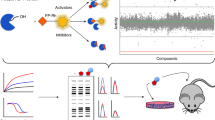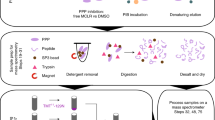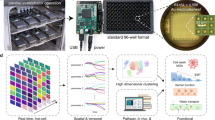Abstract
Here we describe a protocol for the identification of effectors of tissue-nonspecific alkaline phosphatase (TNAP). It is based on a highly sensitive method for detecting TNAP activity. After dephosphorylation by TNAP, a dioxetane-based substrate undergoes a series of chemical transformations resulting in light production. Light intensity serves as a quantitative measure of the velocity of the TNAP-catalyzed reaction in the steady state. This protocol includes guidelines for optimizing the assay and for high-throughput screening in multiwell plates. The assay is sensitive to the influence of diverse effectors of TNAP as long as the assay optimization steps are repeated for each new batch of the enzyme; full optimization is accomplished in under 2 d. Depending on the available equipment, 10,000–100,000 compounds can be screened in an 8-h period. This protocol provides a method of screening TNAP that is 1,000-fold more sensitive and 10-fold faster than a conventional colorimetric assay with p-nitrophenyl phosphate.
This is a preview of subscription content, access via your institution
Access options
Subscribe to this journal
Receive 12 print issues and online access
$259.00 per year
only $21.58 per issue
Buy this article
- Purchase on Springer Link
- Instant access to full article PDF
Prices may be subject to local taxes which are calculated during checkout








Similar content being viewed by others
References
McComb, R.B., Bowers, G.N., Jr. & Posen, S. Alkaline Phosphatase (Plenum Press, New York, USA, 1979).
Millán, J.L. Mammalian Alkaline Phosphatases. From Biology to Applications in Medicine and Biotechnology (Wiley-VCH Verlag, Weinheim, Germany, 2006) pp. 1–322.
Millán, J.L. et al. Enzyme replacement therapy for murine hypophosphatasia. J. Bone Miner. Res. 23, 777–787 (2008).
Fedde, K.N. et al. Alkaline phosphatase knock-out mice recapitulate the metabolic and skeletal defects of infantile hypophosphatasia. J. Bone Miner. Res. 14, 2015–2026 (1999).
Whyte, M.P. et al. Perinatal hypophosphatasia: tissue levels of vitamin B6 are unremarkable despite markedly increased circulating concentrations of pyridoxal-5/-phosphate. Evidence for an ectoenzyme role for tissue-nonspecific alkaline phosphatase. J. Clin. Invest. 81, 1234–1239 (1988).
Holtz, K.M., Stec, B. & Kantrowitz, E.R. A model of the transition state in the alkaline phosphatase reaction. J. Biol. Chem. 274, 8351–8354 (1999).
Stinson, R.A. Kinetic parameters for the cleaved substrate, and enzyme and substrate stability, vary with the phosphoacceptor in alkaline phosphatase catalysis. Clin. Chem. 39, 2293–2297 (1993).
Fishman, W.H. & Sie, H.-G. Organ-specific inhibition of human alkaline phosphatase isoenzymes of liver, bone, intestine and placenta; L-phenylalanine, L-tryptophan and L-homoarginine. Enzymologia 41, 140–167 (1971).
Van Belle, H. Alkaline phosphatase. I. Kinetics and inhibition by levamisole of purified isoenzymes from humans. Clin. Chem. 22, 972–976 (1976).
Farley, J.R., Ivey, J.L. & Baylink, D.J. Human skeletal alkaline phosphatase—kinetic studies including pH dependence and inhibition by theophylline. J. Biol. Chem. 255, 4680–4686 (1980).
Sergienko, E. et al. Identification and characterization of novel tissue-nonspecific alkaline phosphatase inhibitors with diverse modes of action. J. Biomol. Screen 14, 824–837 (2009).
Ardecky, R. et al. Design and synthesis of pyrazole derivatives as potent and selective inhibitors of tissue-nonspecific alkaline phosphatase (TNAP). Bioorg. Med. Chem. Lett. 19, 222–225 (2009).
Brooks, E. & Voyta, J.C. Purification of stable water-soluble dioxetanes. US patent 4,931,569, filed 14 September 1988, and issued 5 June 1990 (1990).
Bronstein, I., Brooks, E. & Rouh-Rong, Juo Chemiluminescent 3-(substituted adamant-2′-ylidene) 1,2-dioxetanes. US patent 5,326,882, filed 30 April, 1992, and issued 5 July 1994 (1994).
Zhang, J.H., Chung, T.D. & Oldenburg, K.R. A simple statistical parameter for use in evaluation and validation of high throughput screening assays. J. Biomol. Screen 4, 67–73 (1999).
Narisawa, S. et al. High throughput screening and identification of novel alkaline phosphatase inhibitors—a druggable target for the treatment of vascular calcification. J. Bone Miner. Res. 22, 1700–1710 (2007).
Dahl, R. et al. Discovery and validation of a series of aryl sulfonamides as selective inhibitors of tissue-nonspecific alkaline phosphatase (TNAP). J. Med. Chem. 52, 6919–6925 (2009).
Fujifilm Life Sciences Fundamentals of Chemiluminescence Detection. Application note no. 6, Fujifilm Life Sciences, Tokyo, Japan, (1998) 〈http://www.fujifilm.de/media/science/6_fundamentals_in_chemiluminescence_detection.pdf〉.
Acknowledgements
This work was supported by NIH Roadmap Initiative Grant U54HG003916 (E.A.S.) and NIH Grant RC1 HL101899 (J.L.M.).
Author information
Authors and Affiliations
Contributions
J.L.M. identified and validated TNAP as a potential therapeutic target. E.A.S. designed and optimized the assay and performed the screening. E.A.S. wrote the paper with guidance and discussion from J.L.M.
Corresponding author
Ethics declarations
Competing interests
The authors declare no competing financial interests.
Rights and permissions
About this article
Cite this article
Sergienko, E., Millán, J. High-throughput screening of tissue-nonspecific alkaline phosphatase for identification of effectors with diverse modes of action. Nat Protoc 5, 1431–1439 (2010). https://doi.org/10.1038/nprot.2010.86
Published:
Issue Date:
DOI: https://doi.org/10.1038/nprot.2010.86
This article is cited by
-
Understanding the enzymatic inhibition of intestinal alkaline phosphatase by aminophenazone-derived aryl thioureas with aided computational molecular dynamics simulations: synthesis, characterization, SAR and kinetic profiling
Molecular Diversity (2021)
-
A quantitative and qualitative RNA expression profiling assay for cell culture with single cell resolution
Cytotechnology (2018)
-
Alkaline Phosphatases in the Complex Chronic Kidney Disease-Mineral and Bone Disorders
Calcified Tissue International (2018)
Comments
By submitting a comment you agree to abide by our Terms and Community Guidelines. If you find something abusive or that does not comply with our terms or guidelines please flag it as inappropriate.



